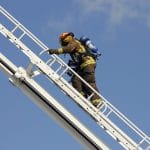On our blog, the team at Emergency Reporting has been working to address and educate our readers on firefighter and first responder specific health issues, such as elevated cancer risks. In this particular article, we will be focusing on an even less talked about health risk that first responders are at a heightened risk for: post-traumatic stress disorder (PTSD) and suicide risk.
Several scientific studies suggest that firefighters are at a higher risk for developing PTSD and have higher rates of suicidal thoughts and behaviors than the general population[1]. Learning to recognize PTSD warning signs is one easy step every department can take to protect their most valuable asset – their team.
8 PTSD Warning Signs
Post-traumatic stress disorder (PTSD) is a trauma and stress-related disorder that can develop after exposure to an event in which death or severe physical harm occurred[2]. PTSD affects about 8 million Americans and is often coupled with depression, substance abuse, and anxiety disorders.
First responders are often first-hand witnesses to tragedies, death, and destruction on a daily basis as a part of their job. This can put them at a higher risk for developing PTSD, which is why it’s so important for stations and families to know what signs to look out for.
Signs Station Crew Should Watch Out For[3]:
Sign #1: Intrusive Memories
People experiencing PTSD often relive traumatic event(s) in vivid memories, which can manifest as flashbacks or nightmares.
Sign #2: Avoidance Behaviors
It’s common for those with PTSD to avoid reminders and feelings associated with their trauma. Examples of these could be certain places, activities, or people. This can cause a potential disruption in the person’s normal daily routine.
Sign #3: Increased Arousal and Reactivity
Symptoms of PTSD related to this can include increased anger or aggression, irritability, insomnia, hypervigilance, and hypersensitivity.
Sign #4: Negative Changes in Mood and Thought
It’s also common for those with PTSD to experience an array of other mental health disorders along with their PTSD. These can include anxiety, depression, and mood disorders. Some symptoms of these may include feelings of detachment and guilt, lack of interest in previously enjoyed activities, negative mood, and distorted beliefs about oneself, others and the world.
Signs Loved Ones Should Watch Out For[4]:
Sign #5: “Vortex of Numb”
The vortex here refers to the stupor your spouse may seem to enter when returning home from work and tuning out the rest of the world by becoming engrossed in the TV, iPad or computer. If they are unable to come out of this “vortex” to answer questions or turn their attention to something else, it may be cause for worry.
Sign #6: “Glass Test”
This test has to do with how we handle stress. People without PTSD usually start their days with an empty glass that fills up with different stressors as the day goes on. Someone suffering from PTSD will start their days with a glass that is already three quarters full. The glass test is seeing how quickly your spouse’s glass overflows and if those stresses are “normal”. Is their threshold of being overwhelmed very low?
Sign #7: “Whatever Wasteland”
Anyone who has ever had a teenager, knows this one well. Does your spouse take responsibility or make decisions without being asked?
Sign #8: “I Used to Syndrome”
Does your spouse often talk about things they used to do that they enjoyed, but don’t do anymore? Keep track of how much they talk about these things and see if you can try to create situations where they can do these things again.
How to Respond If You See PTSD Warning Signs
While these signs may be helpful in identifying PTSD, none of the signs listed above, or other worrying signs you may encounter, are conclusive proof of PTSD. It is a disorder that must be diagnosed by a qualified healthcare provider.
Outside of medical advice, one of the best things you can do is create a culture of openness and honesty as your station. It’s very unlikely that anyone will seek help or treatment if they fear they’ll be punished or ridiculed. Stations should empower all members of your team to freely communicate their concerns without facing repercussions.
Another thing station’s can do is to make sure they have a proactive plan in place for dealing with PTSD. Station leaders should know what resources exist for firefighters on their team on local, state, and federal levels. It’s important to also understand what treatment methods are available to firefighters suffering from PTSD. Some examples of treatments are:
- Cognitive behavior therapy
- Exposure therapy
- Cognitive restructuring
- Cognitive processing therapy
- Eye movement desensitization and reprocessing
- Stress inoculation training
Firefighters should also know how to communicate their concerns about themselves and others in a non-judgmental way. Mental health can be a very hard issue to discuss with others but having the knowledge and plans in place in a workplace where PTSD is common, can end up saving lives.
The most important thing departments can do is create a safe space for their team. If you or someone you know is experiencing symptoms of PTSD, do not be afraid to act. Sweeping issues like this under the rug or just hoping that they will go away on their own could have potentially devastating consequences.
Medical Disclaimer: The information Emergency Reporting provides is not intended to be a substitute for professional medical advice, diagnosis or treatment. It should not be used in place of the advice of your physician or other qualified healthcare provider.
Other Helpful Resources:
- https://www.iaffrecoverycenter.com/blog/ptsd-in-the-fire-service-tackling-myths/
- https://www.firerescue1.com/health/articles/ptsd-treatments-for-firefighters-FCqoCFOFOT8luc0F/
Sources:
[1] https://www.ncbi.nlm.nih.gov/pmc/articles/PMC5825264/#R54
[2] https://www.psychologytoday.com/us/conditions/post-traumatic-stress-disorder
[3] https://www.iaffrecoverycenter.com/behavioral-health/ptsd/
[4] https://www.firerescue1.com/family-home/articles/5-signs-your-firefighter-spouse-has-ptsd-YLMG2PlPvSF3nTuS/



